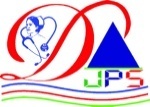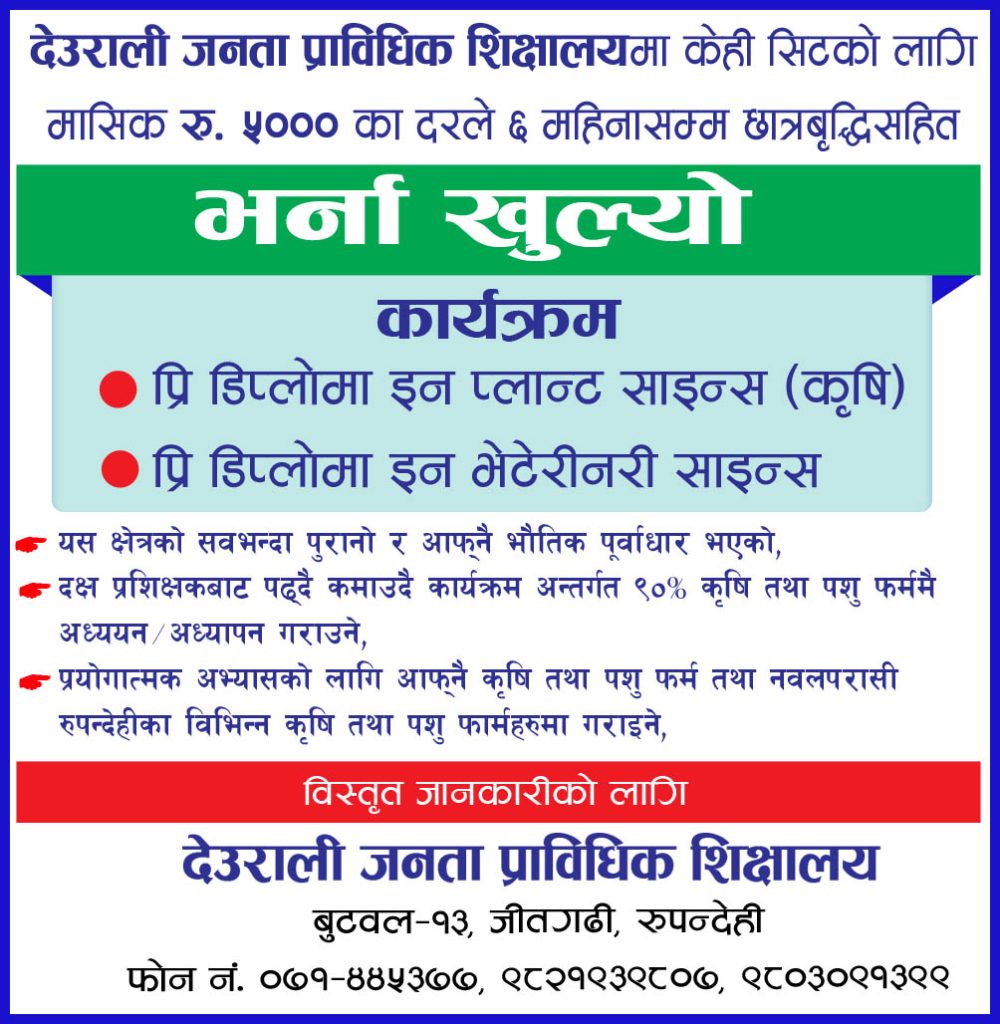Pre-diploma in Veterinary Science

Nepal Government, Ministry of Education implemented the letter grading system in SLC from 2072 B.S. The door of TSLC programme is open for those students who have appeared in SLC exam and achieved any GPA and any grade in each subject. Focusing on such students the curriculum of TSLC of 29 months and 15 months has been converted into 18 months to create uniformity among different TSLC programme.
Pre-Ddiploma In Veterinary Science (TSLE Veterinary JTA) is a 18 months program run under CTEVT affiliation. Nepal being an agricultural country, its economy is predominantly dependent on agriculture and agro-based ventures. Over 65% of the total population of Nepal depends on agriculture. 42% of the GDP is tied up in agriculture sector. At present livestock contributes about 31% to the total AGDP of the country. Milk is by far the most important commodity of livestock with meat next. High productivity from animals and crops is possible only through genetic improvement of animals, scientific management with least cost and scientific cropping system with cost effective respectively and commercialization coverage.
Nepal Government has given high priority in agriculture sector. Most of the INGOs/NGOs are working in agro-livestock sectors. They need agro-veterinary technicians. Potential fields are available for veterinary clinical practice. Employment opportunity will be seen in GON, NARC, INGO/NGO, commercial bank/development bank viz, Nepal bank, ADB/N and abroad (opportunity to work in Israel).
TSLC in Argo-Vet program is designed for lower level human resources in the field of Agriculture services equipped with knowledge, skills and attitude necessary for this level of technicians so as to meet the demand of such technician in the country.
This course is based on the job required to be performed by an agriculture sector in Nepal. This course intends to provide knowledge about following basic level Junior Technical Assistant. It especially provides the knowledge and skills focusing on Agriculture and farm management. To meet the man power needs of the various agricultural institutions in Nepal through the training for the Governmental and nongovernmental sector.
The aim of the programme is to produce Veterinary Junior Technical Assistant (VJTA) who will provide veterinary clinical services and some livestock extension services to the livestock community being either wage or self-employed in the country or abroad.
After completing this curricular program, the students will be able:
- To extend skills and knowledge of veterinary science (medicine) to the livestock farming communities in order to contribute in community development as well as entrepreneurship development.
- To provide suggestion about animal nutrition and fodder production to the livestock farmers To facilitate farmers for scientific production of livestock / livestock products.
- To make farmers conscious about veterinary epidemiological hazards and its impact on public health and related precautions to be taken
- To diagnose/treat/manage diseases/disorders of livestock and poultry.
- To provide disease treatment/management services to the livestock farming communities
- To handle simple surgical cases
- To handle simple gynecological cases and cases of obstetrics
This course will be completed within 18 months (40 hrs./week X 39 week a year = 1560 hrs.) class plus 6 month (40 hrs./week X 24 week = 960 hrs.) on the job training (OJT).
Individuals with following criteria will be eligible for this program:
- SLC with any grade and any GPA (Since 2072 SLC).
- SLC appeared (Before 2072 SLC)
- Pass entrance examination administered by CTEVT
The medium of instruction will be in English and/or Nepali language. The medium of instruction will be in English and/or Nepali language. The methods of teaching for this curricular program will be a combination of several approaches. Such as: Theory: lecture, discussion, assignment, group work and Practical: demonstration, simulation, observation, guided practice and self-practice
The following instructional media and materials are suggested for the effective instruction and demonstration.
- Printed media materials (assignment sheets, handouts, information sheets, individual training packets, procedure sheets, performance check lists, textbooks etc.).
- Non-projected media materials (display, photographs, flip chart, poster, writing board etc.).
- Projected media materials (opaque projector, overhead transparencies, slides etc.). Audio-visual materials (audiotapes, films, slide-tape programs, videodiscs, videotapes, multimedia etc.).
- Computer-based instructional materials (computer-based training, interactive video etc.) Teaching learning methodologies
The council for technical education and vocational training will award certificate of “Technical School Leaving Certificate in Veterinary Science” to those students who successfully complete the requirements prescribed by the curriculum.
- The graduate will be eligible for the position equivalent to Non-gazetted 2nd class/level 4 (technical) as Junior Technical Assistant (Veterinary- JTA) in the field of Veterinary services or as prescribed by the Public Service Commission.
- Employment opportunity will be seen in GON, NARC, INGO/NGO, commercial bank/development bank, viz, Nepal bank, ADB/N and abroad (opportunity to work in Israel).
This curriculum is based on the job required to be performed by agriculture sector in Nepal. It intends to provide knowledge required for basic level Junior Technical Assistant. It especially provides the knowledge and skills focusing on agriculture and farm management. The curriculum reflects the need of present agriculture services, the professionalism in agriculture sectors, so that the graduates of this program will be readily acceptable by the farmers at community level.
Course Structure of Agriculture (Plant Science) | |||||||||
SN | Subjects | Nature | Hours/ week | Hours Distribution | Marks Distribution | ||||
Theory | Practical | Total | Theory | Practical | Total | ||||
1. | Veterinary Extension and Communication | T + P | 4 | 32 | 124 | 156 | 20 | 80 | 100 |
2. | Veterinary Anatomy and Physiology | T + P | 2 | 16 | 62 | 78 | 10 | 40 | 50 |
3. | Animal Nutrition and Fodder Production | T + P | 2 | 16 | 62 | 78 | 10 | 40 | 50 |
4. | Veterinary Epidemiology and Public Health | T + P | 2 | 16 | 62 | 78 | 10 | 40 | 50 |
5. | Animal Husbandry and Entrepreneurship Development | T + P | 8 | 64 | 248 | 312 | 40 | 160 | 200 |
6. | Veterinary Medicine | T + P | 12 | 96 | 372 | 468 | 60 | 240 | 300 |
7. | Veterinary Laboratory Technology | T + P | 4 | 32 | 124 | 156 | 20 | 80 | 100 |
8. | General Veterinary Pharmacology | T + P | 2 | 16 | 62 | 78 | 10 | 40 | 50 |
9. | Theriogenology and Basic Surgery | T + P | 4 | 32 | 124 | 156 | 20 | 80 | 100 |
Subtotal: | 40 | 320 | 1240 | 1560 | 200 | 800 | 1000 | ||
On the job training (OJT) | P | 0 | 960 | 960 | 0 | 500 | 500 | ||
Grand Total: | 320 | 2200 | 2520 | 200 | 1300 | 1500 | |||

